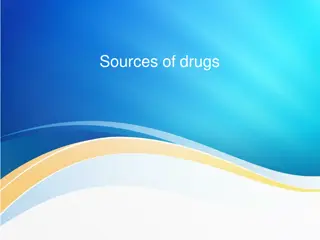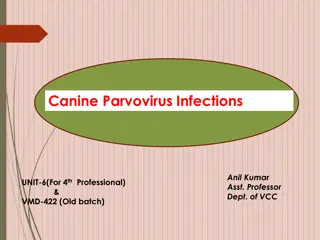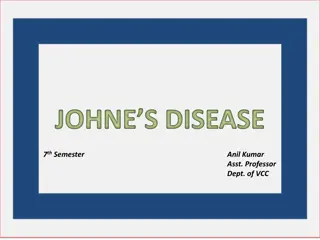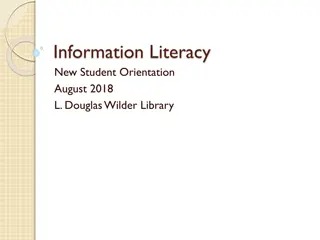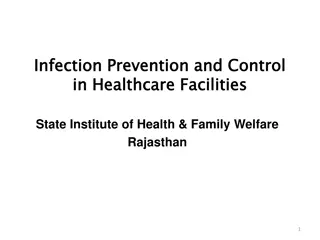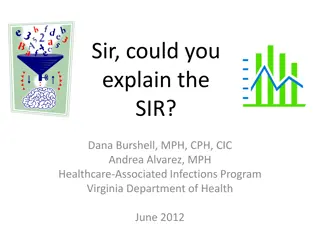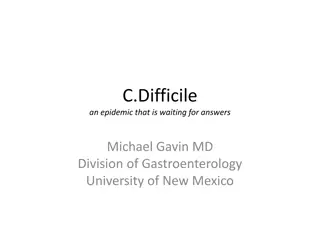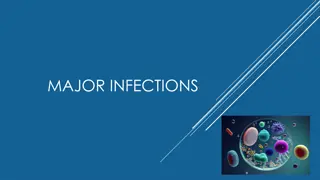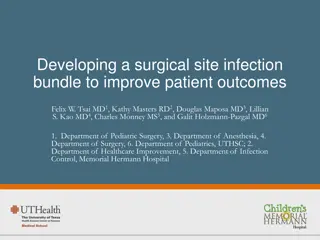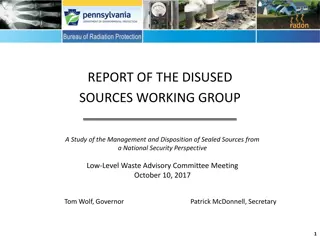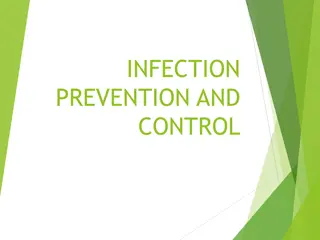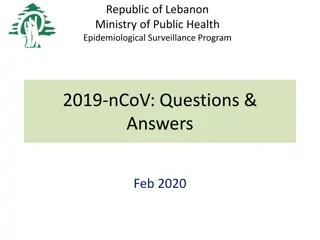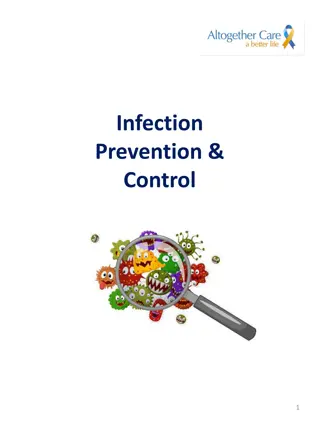Botulism: Causes, Infection Sources, and Clinical Presentations
Botulism is caused by Clostridium botulinum, a neurotoxin-producing bacterium. This article discusses the etiology, sources of infection, pathogenesis, and clinical findings of botulism in various animal species such as cattle, horses, and sheep. It covers how the toxins of C. botulinum lead to functional paralysis without histologic lesions, resulting in symptoms like muscular paralysis, ataxia, and difficulty swallowing. Understanding these aspects is crucial for prompt diagnosis and treatment of botulism in animals.
Download Presentation

Please find below an Image/Link to download the presentation.
The content on the website is provided AS IS for your information and personal use only. It may not be sold, licensed, or shared on other websites without obtaining consent from the author.If you encounter any issues during the download, it is possible that the publisher has removed the file from their server.
You are allowed to download the files provided on this website for personal or commercial use, subject to the condition that they are used lawfully. All files are the property of their respective owners.
The content on the website is provided AS IS for your information and personal use only. It may not be sold, licensed, or shared on other websites without obtaining consent from the author.
E N D
Presentation Transcript
BOTULISM By Dr. Hussein AlNaji
ETIOLOGY 2 The causative organism C. botulinum, a spore-forming obligate anaerobe, produces neurotoxins during vegetative growth. Botulinum neurotoxin forming C. botulinum species are divided into groups I to IV depending on their physiologic properties. Group I: proteolytic C. botulinum type A, B and F. These types degrade protein such as milk, serum, meat, and chicken protein. Group II: nonproteolytic C. botulinum, includes nonprotelytic type B and F and all type E. Group III: C. botulinum type C and D . Group IV: C. botulinum type G.
3 Source of infection 1. Forage botulism : occurs when pH, moisture, and anaerobic conditions in the feedstuff allow the vegetative growth of C. botulinum and the production of toxin. 2. Decaying vegetable material. 3. Carrion-Associated Botulism This is almost always the cause of botulism in animals on pasture, and carrion is also a common cause of botulism in animals on conserved feeds. 4. Wound botulism is a toxicoinfectious form of botulism where the toxin is produced in wounds infected by C. botulinum. Toxicoinfectious Botulism This results when toxin is produced by C. botulinum present in the intestine
Pathogenesis 4 The toxins of C. botulinum are neurotoxins and produce functional paralysis without the development of histologic lesions. The toxins absorbed from the intestinal or the wound and carried via the blood stream Peripheral cholinergic nerve terminals including neuromuscular junctions, postganglionic parasympathetic nerve endings, and peripheral ganglia. The light chain of the toxin for resultant blockade of the release of acetylcholine at the neuromuscular junction. The heavy chain of the toxin is responsible for binding to the receptors and translocation into the cell Flaccid paralysis develops and the animal may die of respiratory paralysis.
CLINICAL FINDINGS 5 1- Cattle and Horses Signs usually appear 3 to 17 days after the animals gain access to the toxic material, but occasionally as soon as day 1. 2- Peracute cases die without prior signs of illness. The disease is not accompanied by fever, and the characteristic clinical picture is one of progressive symmetric muscular paralysis affecting particularly the limb muscles and the muscles of the jaw, tongue, and throat. 3- Subacute. Restlessness, incoordination, stumbling, knuckling, and ataxia are followed by inability to rise or to lift the head. Mydriasis and ptosis occur early in the clinical course; mydriasis can be prominent in type C botulism in the horse. 4- In some cases the tongue becomes paralyzed and hangs from the mouth, the animal is unable to chew or swallow, and it drools saliva.
6 Sheep Sheep do not show the typical flaccid paralysis of other species until the final stages of the disease. There is stiffness while walking and incoordination and some excitability in the early stages. The head may be held on one side or bobbed up and down while walking (limber neck).
7 CLINICAL PATHOLOGY 1. There are no changes in hematologic values or serum biochemistry that are specific to botulism. 2. Laboratory diagnosis of botulism in the live or dead animal is difficult because of the lack of sensitive confirmatory laboratory tests NECROPSY FINDINGS There are no specific changes detectable at necropsy
8 DIFFERENTIAL DIAGNOSIS A presumptive diagnosis is made on the clinical signs and history, occurrence in unvaccinated animals, and the ruling out of other diseases with a similar clinical presentation. Horses Ruminants 1. Equine encephalomyelitis\ 2. Equine herpesvirus-1 myeloencephalopathy 3. Atypical myopathy of unknown etiology; the condition that presents frequently fatal myopathy can be differentiated by the characteristic increase in serum creatine kinase activity and hemoglobinuria 4. Equine motor neuron disease 5. Hyperkalemic periodic paralysis 6. Hepatic encephalopathy 7. Paralytic rabies. 1. Periparturient hypocalcemia, characterized by low serum calcium concentrations and responsiveness to parenteral calcium administration 2. Hypokalemia, characterized by marked hypokalemia 3. Tick paralysis 4. Paralytic rabies 5. Organophosphate/carbamate poisoning the presence of
9 Treatment Type-specific antiserum and supportive treatment. Control Avoidance of exposure by feed management. Vaccination
10 Thank You




